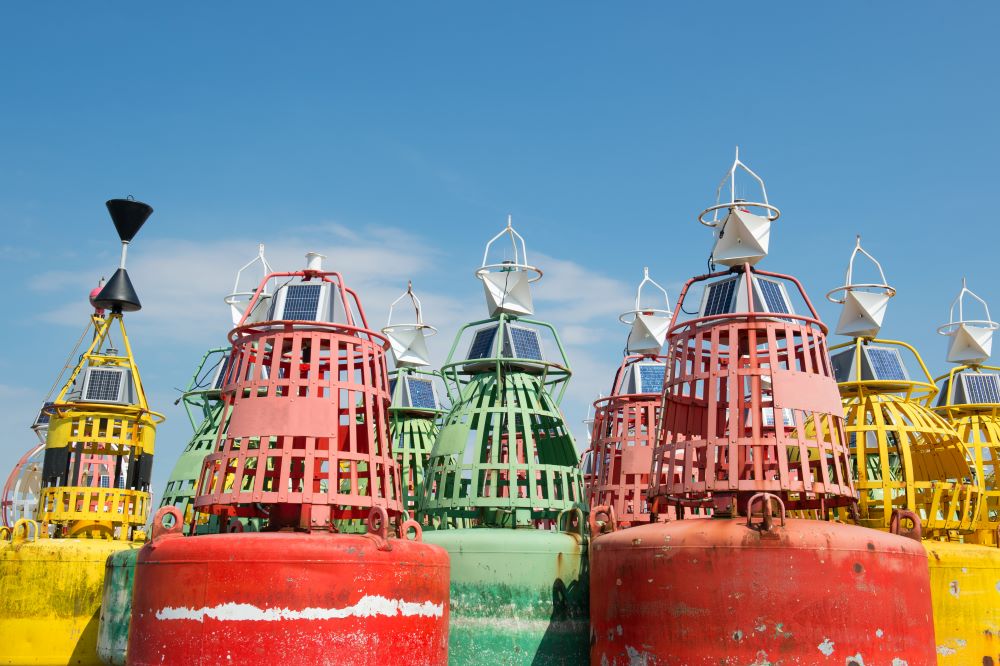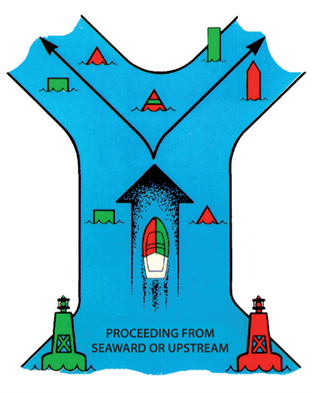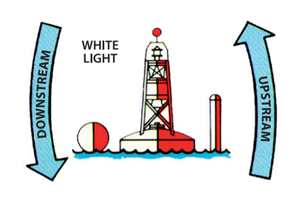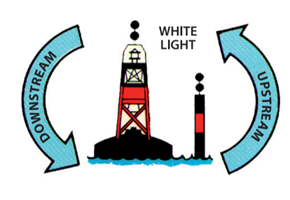
Recognizing Marine Buoys and Markers in Canada
Buoys and markers are floating devices that are used to guide boats on the water and provide important navigational information. Also called floating aids to navigation, they come in many colours and patterns, each of which have their own meaning.
Since buoys help ensure the safety of vessels at sea, in shipping lanes and near coasts and ports, it’s vital for both pleasure boaters and captains of large commercial ships to be able to recognize them and understand their meaning.
Read on for a comprehensive overview of marine buoys and markers in Canada.
Shapes of buoys and markers
Before getting into the navigational information that buoys can provide, it’s important to know what they look like.
Marine buoys and markers can come in many different shapes. Beacons, spars, spherical or conical buoys and pillars are some of the markers you’re most likely to see while boating.
Note that the buoy’s shape doesn’t necessarily affect the information it conveys. Other visual characteristics such as colour and pattern are what give buoys their meaning.
Many buoys are equipped with lights to make them easier to see in the dark and in conditions that reduce visibility.
Types of buoys
In order to be able to comply with regulations, boaters need to be able to recognize the following types of buoys and their meanings:
Lateral buoys
Lateral buoys are used to mark the side of the waterway that boaters should use when heading upstream. Following the routes indicated by these buoys helps boaters avoid collisions and dangerous obstacles.
Port hand buoys
Port hand buoys are coloured green and marked with odd numbers. They should be kept on your port (left) side as you head upstream.
Starboard hand buoys
Starboard hand buoys are coloured red and marked with even numbers. They should be kept on your starboard (right) side as you head upstream.
Bifurcation buoys
Bifurcation buoys mark the point where a waterway splits in two and indicate the route for vessels moving upstream. The main or preferred channel is indicated by the colour of the uppermost band.
For example, port bifurcation buoys are green with a horizontal red band and indicate that the recommended route is on the starboard (right) side of the buoy.
Starboard bifurcation buoys are red with a horizontal green band and indicate that the recommended route is on the port (left) side of the buoy.
Fairway buoys
Fairway buoys indicate safe water. They have red and white vertical stripes of equal width. They may carry a topmark that consists of a single red sphere.
You may pass a fairway buoy on either side, but it is preferable to keep it on your port (left) side.
Isolated danger buoys
Isolated danger buoys mark a hazard surrounded by navigable water. They are black with one horizontal red band. They may also carry a topmark that consists of two black spheres, one on top of the other.
Cardinal buoys
Cardinal buoys are black and yellow buoys that indicate the safest or deepest water using the cardinal points of a compass.
There are four types of cardinal buoys, one for each cardinal point.
North cardinal buoy
A north cardinal buoy indicates that safe water can be found north of it. The top half of the buoy is black, and the bottom half is yellow.
East cardinal buoy
An east cardinal buoy indicates that safe water can be found east of it. The buoy is black with one broad yellow band.
South cardinal buoy
A south cardinal buoy indicates that safe water can be found south of it. The top half of the buoy is yellow, and the bottom half is black.
West cardinal buoy
A west cardinal buoy indicates that safe water can be found west of it. The buoy is yellow with one broad black band.
Special buoys
Special buoys provide boat operators with specific information. Pleasure boaters need to know the meanings of these types of buoys in addition to those listed above.
Mooring buoys
Mooring buoys are used to moor vessels. Their top third is orange and the rest is white.
Anchorage buoys
Anchorage buoys mark the perimeter of an anchorage area. They are yellow with black anchor symbols.
Cautionary buoys
Cautionary buoys mark danger areas (military exercise areas, underwater structures, areas with no safe channel, etc.) They are entirely yellow.
Control buoys
Control buoys mark areas where boats are restricted and must obey specific rules (speed limits or wash restrictions, for example). They are white with orange bands and an orange circle.
Keep-out buoys
Keep-out buoys mark areas where boats are prohibited. They are white with orange bands and an orange diamond containing a cross.
Hazard buoys
Hazard buoys mark dangers such as rocks or turbulent waters. They are white with orange bands and an orange diamond.
Diving buoys
Diving buoys mark scuba diving areas that boats should keep well away from. These buoys are white and sport a red flag with a diagonal white stripe.
Swimming buoys
Swimming buoys mark the perimeter of a swimming area. They are entirely white.
Information buoys
Information buoys provide information for boat operators (the name of the location, marina, etc.). They are white with orange bands and an orange square.
Boat safely with the National Boating Safety School
In order to boat safely, you need to be able to recognize the various types of marine buoys and markers and understand their meanings.
Feel free to read this article through several times to make sure you remember the information it contains. You can even bookmark it so that you can find it again if you need it!
If you want to learn more about boating safety and pleasure boating, the National Boating Safety School is a great resource. Our boat safety course prepares you for the official boat exam.
















